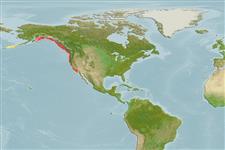>
Perciformes/Cottoidei (Sculpins) >
Cottidae (Sculpins)
Etymology: Icelinus: From Icelus = the Morpheus name; mythology; burchami: Named after James S. Burcham, U.S. Bureau of Fisheries (Ref. 6885).
More on authors: Evermann & Goldsborough.
Environment: milieu / climate zone / depth range / distribution range
Ökologie
seewasser demersal; tiefenbereich 61 - 570 m (Ref. 6885). Temperate; - 32°N
Eastern Pacific: Behm Canal, southeastern Alaska (Ref. 2850) to San Nicholas Island and La Jolla, southern California, USA.
Size / Gewicht / Alter
Maturity: Lm ? range ? - ? cm
Max length : 13.0 cm TL Männchen/unbestimmt; (Ref. 2850)
Rückenflossenstacheln (insgesamt): 9 - 10; Rückenflossenweichstrahlen (insgesamt): 16-18; Afterflossenstacheln 0; Afterflossenweichstrahlen: 12 - 14. Caudal fin narrowly rounded; pelvic fins very small, extending one-fifth to one-sixth of distance to anal origin (Ref. 6885). Preserved specimens yellowish brown with small light spots and dark irregular blotches; dorsal, caudal, anal, and pectoral fins dark, blotched with white (Ref. 6885).
Occurs offshore (Ref. 2850). Most common near drop-offs (Ref. 2850).
Life cycle and mating behavior
Geschlechtsreife | Fortpflanzung | Ablaichen | Eier | Fecundity | Larven
Eschmeyer, W.N., E.S. Herald and H. Hammann, 1983. A field guide to Pacific coast fishes of North America. Boston (MA, USA): Houghton Mifflin Company. xii+336 p. (Ref. 2850)
IUCN Rote Liste Status (Ref. 130435)
Bedrohung für Menschen
Harmless
Nutzung durch Menschen
Mehr Information
NamenSynonymeMetabolismusRäuberÖkotoxikologieFortpflanzungGeschlechtsreifeAblaichenSpawning aggregationFecundityEierEientwicklung
ReferenzenAquakulturAquakultur ProfilZuchtlinienGenetikElectrophoresesVererbbarkeitKrankheitenVerarbeitungNutrientsMass conversion
PartnerBilderStamps, Coins Misc.LauteCiguateraGeschwindigkeitSchwimmstilKiemenoberflächeOtolithsGehirngrößeSehfähigkeit
Tools
Zusatzinformationen
Download XML
Internet Quellen
Estimates based on models
Preferred temperature (Ref.
123201): 4.6 - 8.6, mean 5.9 °C (based on 108 cells).
Phylogenetic diversity index (Ref.
82804): PD
50 = 0.5005 [Uniqueness, from 0.5 = low to 2.0 = high].
Bayesian length-weight: a=0.00676 (0.00300 - 0.01523), b=3.17 (2.98 - 3.36), in cm total length, based on LWR estimates for this (Sub)family-body shape (Ref.
93245).
Trophic level (Ref.
69278): 3.5 ±0.5 se; based on size and trophs of closest relatives
Widerstandsfähigkeit (Ref.
120179): mittel, Verdopplung der Population dauert 1,4 - 4,4 Jahre. (Preliminary K or Fecundity.).
Fishing Vulnerability (Ref.
59153): Low vulnerability (10 of 100).
